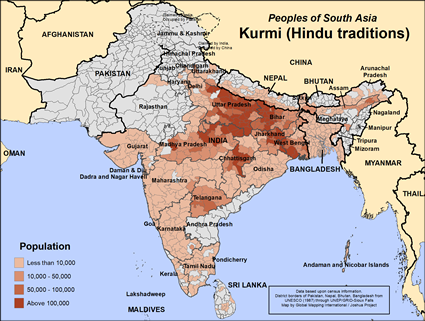Kurmi (Hindu traditions) in India

Photo Source:
Anonymous
|

Map Source:
People Group Location: Omid. Other geography / data: GMI. Map Design: Joshua Project
|
| People Name: | Kurmi (Hindu traditions) |
| Country: | India |
| 10/40 Window: | Yes |
| Population: | 19,359,000 |
| World Population: | 19,671,000 |
| Primary Language: | Hindi |
| Primary Religion: | Hinduism |
| Christian Adherents: | 0.01 % |
| Evangelicals: | 0.00 % |
| Scripture: | Complete Bible |
| Ministry Resources: | Yes |
| Jesus Film: | Yes |
| Audio Recordings: | Yes |
| People Cluster: | South Asia Hindu - Kurmi |
| Affinity Bloc: | South Asian Peoples |
| Progress Level: |
|
Introduction / History
Kurmi is the name given to a Hindu caste in India. The caste system in India is a pattern of social stratification associated with Hinduism. The word "kurmi" literally means the "I cans" or the "I am ables". The Kurmi are also known as Kunbi. The Kurmi are believed to be descendants of some of the earliest Aryan immigrants to India and come from the Kshatriyas (warrior caste) who became farmers. Kurmi are known in India as the chief agricultural caste.
The word "kurmi" is related to the word karmi derived from the word "karma" (action or merit). Defining caste by karma instead by lineage and birth was a major change of defining caste instead of that based on birth lineage and ancestry linked to the Vedas (ancient Hindu scriptures) and espoused by Brahmins (priestly caste).
Historical writers say that the relationship between the Kshatriyas (warrior caste) and the Brahmins became strained. Consequently Brahmins started keeping the Vedas a secret from the Kshatriyas. A Vedic Kshatriya was a defender of the faith and righteous order. However, some Kshatriyas, influenced by Buddha and Mahavira, decided they did not need Vedic scriptures for supreme spiritual self mastery or to define their lineage or caste. Kshatriyas in India's northern Empires adopted Buddhism and Jainism.
Where Are they Located?
The Kurmis are found throughout India, from Punjab to Bengal in the east as well as southern India. The Barwar community of Uttar Pradesh and Bihar are descendents of the Kurmi.
What Are Their Lives Like?
Modern Kurmi are relatively prosperous and educated. Their lifestyle is associated with farming and trading. Due to their agricultural link, the Kurmi are viewed as one of the 'backward' or lower castes. Some Kurmi have formed a national movement in the northern and eastern Indian regions for advocacy purposes.
What Are Their Beliefs?
Kurmis are Hindus. Buddhists and Jains can be found amongst them, as well.
What Are Their Needs?
The Kurmi need the salvation offered by God. They need Jesus Christ. A key issue for the Kurmi is their desire to be recognised by other castes as belonging to the warrior caste of Kshatriya.
Prayer Points
Pray that the Kurmi may realize that Jesus is their only hope for salvation and any lasting status.
The Lion of Judah is offering the Kurmi the right to be a special people and royal priests of the Almighty.
Pray that the Kurmi as a whole heed this call and give their hearts in a positive response.